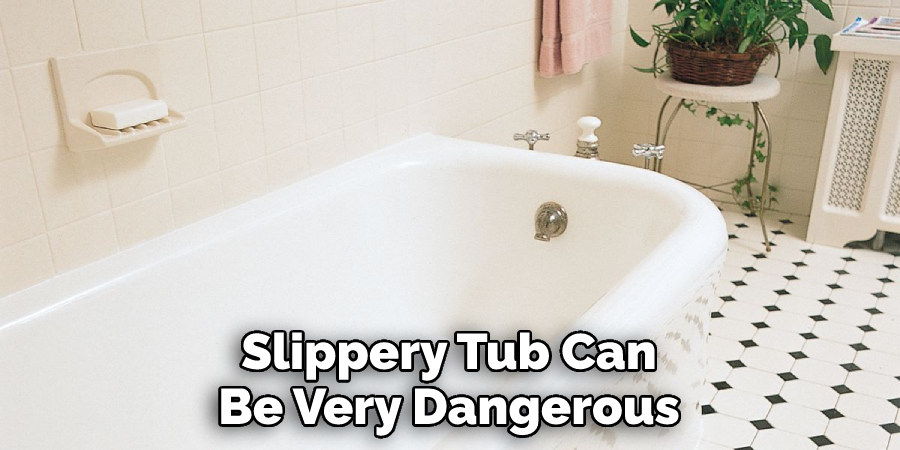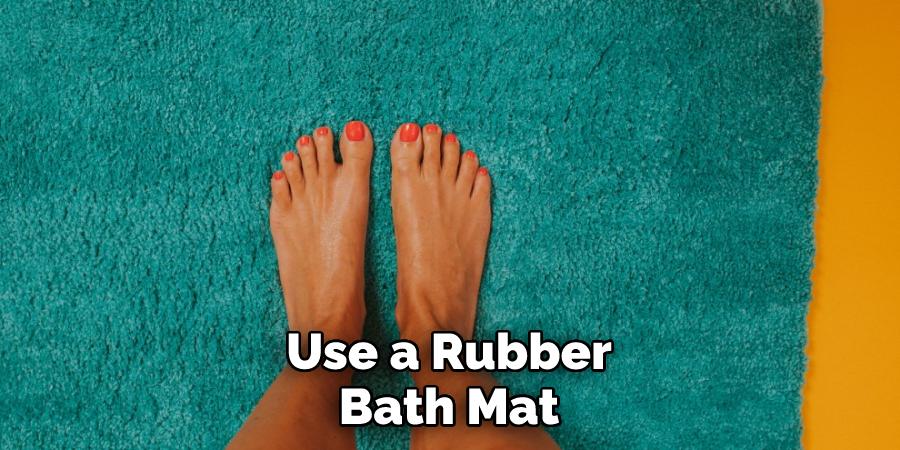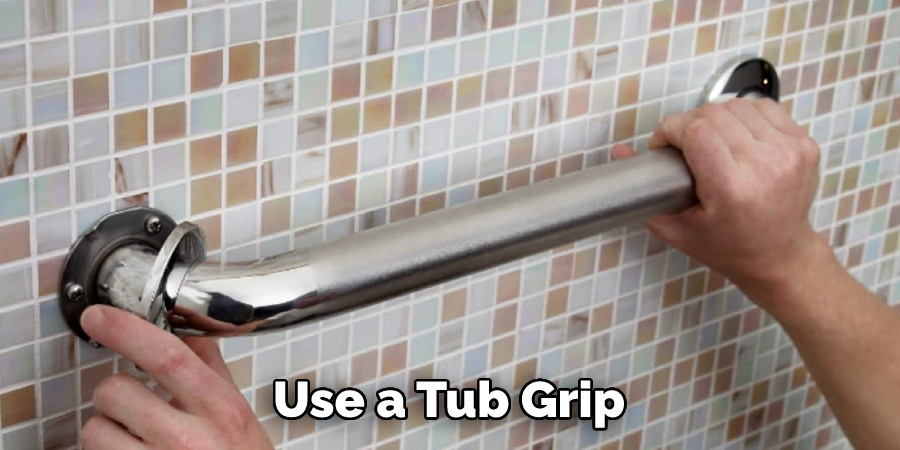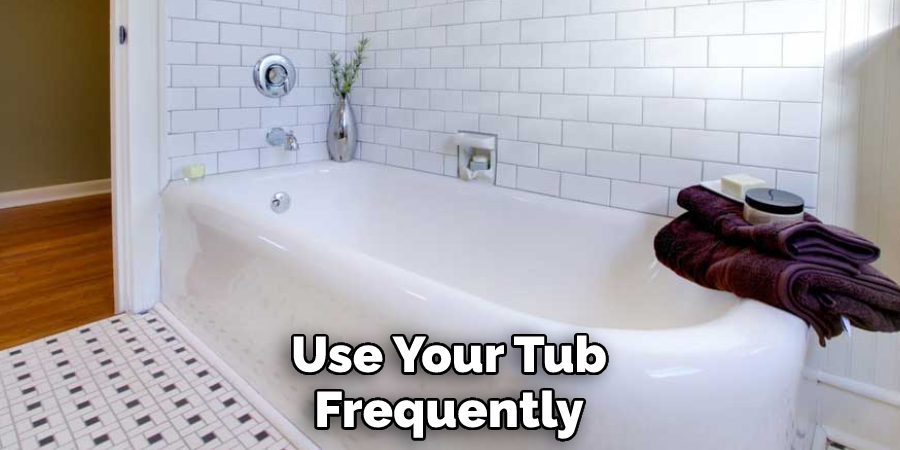If you’ve ever had the unfortunate experience of slipping and falling while showering or bathing, you know how dangerous it can be. A slippery porcelain tub can result in a nasty fall, which may lead to serious injury. Fortunately, there are several things you can do to make your tub less slippery and safer to use. This article will show you how to fix a slippery porcelain tub. Keep reading to learn more!

Summary: Fixing a slippery porcelain tub can be done easily with a few supplies. Start by cleaning the tub with a non-abrasive cleaner, then rinse it off and let it dry completely.
Next, apply an anti-slip solution, such as a rubber bath mat, over the surface of the tub or use a spray-on anti-slip product. To finish, add a coat of wax to protect against future slipping.
What Causes a Porcelain Tub to Become Slippery?
A few different things can cause a porcelain tub to become slippery. One of the most common causes is soap scum build-up. Soap scum is a thin film of soap residue that can accumulate on the surface of your tub over time. This build-up can make your tub slick and dangerous to use. Another common cause of a slippery tub is mineral deposits.
These deposits can come from hard water, which is water that contains high levels of minerals such as calcium and magnesium. When these minerals build up on the surface of your tub, they can make it slick and difficult to grip. Additionally, oily products such as bubble baths or body wash can leave a slippery residue on the surface of your tub.
If you don’t clean this residue off, it can make your tub dangerously slippery. The other main cause of a slippery tub is worn and tear. Over time, the surface of your tub can become worn down, making it more difficult to grip. This wear and tear can be caused by everyday use and by cleaning products and chemicals. Lastly, some porcelain tubs have a smooth, glossy finish, making them more slippery than others.
Why Is It Important to Fix a Slippery Tub?
A slippery tub can be a serious safety hazard. If you or someone else slips and falls while using the tub, it can lead to serious injuries such as broken bones, concussions, and even death. In fact, slip and fall accidents are one of the leading causes of injuries in the home. According to the National Safety Council, slip and fall accidents account for nearly one million visits to the emergency room every year.
Additionally, a slippery tub can be very dangerous for young children and seniors. These groups are more likely to suffer serious injuries from a fall. If you have young children or seniors in your home, it’s especially important to ensure your tub is safe. Another reason why it’s important to fix a slippery tub because it can be very costly. A fall in the tub can damage your tub, surrounding bathroom, and even your home.
You may be liable for your medical bills if someone is seriously injured in a fall. In some cases, you may even be sued. Therefore, ensuring your tub is safe and avoids any potential accidents is important.

Some Easy Ways on How to Fix a Slippery Porcelain Tub
1. Use a Non-slip Mat
One of the easiest and most effective ways to make your tub less slippery is to use a non-slip mat. These mats are designed to grip the surface of your tub and provide a safe, slip-resistant surface. There are various types of non-slip mats available, so be sure to choose one specifically designed for use in a tub. To use a non-slip mat, first, make sure your tub is clean and dry.
Then, place the mat on the bottom of the tub in your desired location. For best results, use multiple mats placed strategically around the tub.
2. Install Non-slip Stickers
If you don’t want to use a mat, another option is to install non-slip stickers. These stickers are similar to mats in that they provide a textured surface that helps prevent slipping. However, they’re much smaller and less noticeable. You can find them at most home improvement stores.
First, clean the tub thoroughly. Then, measure the tub, so you know how many stickers you need. Next, peel off the backing and stick the stickers to the tub. Be sure to press them firmly in place. Finally, test the stickers by running water over them. If they start to peel up, try repositioning them. Avoid using stickers near the drain, as they can interfere with drainage.
3. Use a Rubber Bath Mat
Another option for making your tub less slippery is to use a rubber bath mat. These mats are made of natural rubber and are designed to create a non-slip surface in your tub. They are also comfortable to stand on and can add a bit of cushioning to your feet. First, use a rubber bath mat to ensure that your tub is clean and dry. Then, place the mat in the tub to cover the entire bottom surface.
Use a mat with suction cups on the bottom to keep it in place for best results. You can find these mats at most home goods stores.

4. Add texture to the tub
If you don’t want to use a mat or stickers, another option is to add texture to the tub itself. This can be done by using sandpaper to roughen up the tub’s surface. You’ll want to use medium-grit sandpaper for this project. First, wet the tub’s surface and then sand it in a circular motion. Be sure to sand evenly so that the entire surface is roughed up. Once you’re finished, rinse off the tub and dry it with a towel. Please avoid using the tub until it’s completely dry to prevent slipping.
5. Use a Tub Refinishing Kit
If you’re looking for a more permanent solution, you can use a tub refinishing kit. This will allow you to add a new layer of porcelain to your tub, providing a more slip-resistant surface. You can find these kits at most hardware stores. First, clean the tub thoroughly and remove any dirt, soap scum, or other debris.
Next, follow the instructions included in the kit to apply the new layer of porcelain. Once it’s dry, your tub will have a brand new finish that should be much more slip-resistant. If you’re not comfortable doing this yourself, you can always hire a professional to do it for you.
6. Use a Tub Grip
Another option for making your tub less slippery is to use a tub grip. These are adhesive strips that you apply to the bottom of the tub. They provide a textured surface that gives you more traction and makes it less likely that you’ll slip. You can find them at most home improvement stores. To apply them, first clean the bottom of the tub thoroughly. Then, peel off the backing on the strips and press them into place. Let them sit for a few hours to set before using the tub. If you have a textured bottom on your tub, you may not need to use strips.

7. Rinse Off After Using Soap
If you’re using soap in your tub, be sure to rinse off afterward. Soap can leave a slippery film on the tub’s surface that can cause you to slip and fall. To avoid this, rinse off with clean water after using soap in your tub. If you don’t have a shower head in your tub, you can use a cup or pitcher to pour water over yourself.
Tips and Warnings on How to Fix a Slippery Porcelain Tub
Tips
- For a quick fix, try sprinkling baby powder, cooking oil, or cornstarch on the tub floor.
- Another temporary measure is to place a bath mat or non-slip appliqué in the tub.
- Consider scrubbing the tub with a pumice stone or other abrasive to create a more textured surface.
- If your tub is porcelain-coated cast iron, you can sand the surface with fine-grit sandpaper to rough it up a bit.
- You can also buy a commercial non-slip bath treatment, which usually comes in the form of a spray or aerosol to apply to the tub surface.
- For a more permanent solution, you can install a textured bathtub applique or have the tub resurfaced by a professional.
Warnings
- Do not use abrasives on acrylic tubs, as this can damage the surface.
- When using any treatment on your tub, be sure to follow the manufacturer’s instructions carefully.
- Do not use treatments that increase the risk of slippings, such as oil-based products, on stairs or other areas where people could fall.
- If you have any concerns about making your tub more slip-resistant, consult a professional before taking any action.
How Often Should You Refinish Your Bathtub?
Ideally, it would be best if you refinished your bathtub every five to seven years. However, this will depend on how often you use your tub and how well you take care of it. If you use your tub frequently, you may need to refinish it more often. Likewise, if you don’t take good care of it, you may need to refinish it sooner.

Conclusion
So there you have it! This is how to fix a slippery porcelain tub. By following these tips, you can make your tub much safer and less likely to cause you to slip and fall. Do you have other tips on fixing a slippery porcelain tub? Please share them with us in the comments below!
